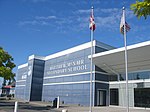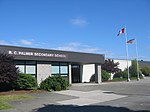McRoberts Secondary School

Hugh McRoberts Secondary School, officially "École Secondaire Hugh McRoberts Secondary School", is a Canadian school in Richmond, British Columbia. Named after Hugh McRoberts, an early settler on Sea Island, this secondary school (grades 8-12 in British Columbia) is one of the two schools in Richmond that offer the French Immersion Secondary School program (the other being McMath). McRoberts is situated at Garden City Rd. and Williams Rd. and is a member of School District 38 Richmond. Hugh McRoberts Secondary School opened on November 30, 1962 and was converted into a full-fledged secondary school in the mid-1990s, with the first class of the new grade 8-12 program graduating in 1997. The high school was partially renovated in 1999. The school logo and mascot is a "Striker", which is depicted as a mounted knight carrying a lance or a claymore. The logo had previously been a shamrock. In 2006, the Fraser Institute evaluated Hugh McRoberts Secondary as the highest ranking school compared to other secondary schools in Richmond, with an average ranking of 8.3 out of 10.0 for all schools in the Greater Vancouver Regional District.
Excerpt from the Wikipedia article McRoberts Secondary School (License: CC BY-SA 3.0, Authors, Images).McRoberts Secondary School
Williams Road, Richmond Broadmoor (Broadmoor)
Geographical coordinates (GPS) Address Phone number Website External links Nearby Places Show on map
Geographical coordinates (GPS)
| Latitude | Longitude |
|---|---|
| N 49.140277777778 ° | E -123.126125 ° |
Address
École Secondaire Hugh McRoberts Secondary School
Williams Road 8980
V7A 1G3 Richmond, Broadmoor (Broadmoor)
British Columbia, Canada
Open on Google Maps






